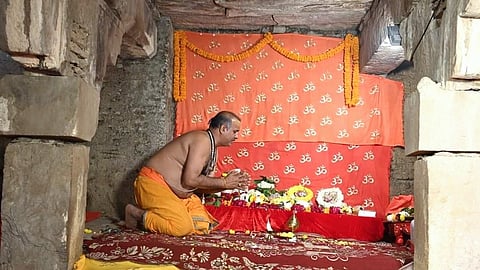Varanasi court permits prayers at Gyanvapi mosque
A Varanasi court on Wednesday allowed Hindu devotees to offer prayers inside the 'Vyas Ka Tekhana' area inside the Gyanvapi mosque complex.
The court has asked district administration to make the necessary arragments in the next seven days.
Advocate Vishnu Shankar Jain, representing the Hindu side told ANI, "Puja will start within seven days. Everyone will have the right to perform Puja..."
"Hindu side allowed to offer prayers at 'Vyas Ka Tekhana'. The District Administration will have to make arrangements within 7 days," Jain said.
The mosque has four 'tahkhanas' (cellars) in the basement out of which one is still in possession of the Vyas family who used to live here.
Vyas had petitioned that as hereditary pujari he be allowed to enter the tahkhana and resume puja.
Notably, The Archaeological Survey of India (ASI) report on the Gyanvapi mosque complex revealed that a pre-existing structure appeared to have been destroyed in the 17th century, and "part of it was modified and reused," adding that based on scientific studies, it can be said that there "existed a large Hindu temple prior to the construction of the existing structure."
"The Arabic-Persian inscription found inside a room mentions that the mosque was built in the 20th regnal year of Aurangzeb (1676-77 CE). Hence, the pre-existing structure appears to have been destroyed in the 17th century, during the reign of Aurangzeb, and part of it was modified and reused in the existing structure. Based on scientific studies/ survey carried out, study of architectural remains, exposed features and artefacts, inscriptions, art and sculptures, it can be said that there existed a Hindu temple prior to the construction of the existing structure," the ASI said in its report.
"Based on the scientific studies and observations on central chamber and main entrance of the pre-existing structure in existing structure, western chamber and western wall, reuse of pillars and pilasters of pre-existing structure in the existing structure, inscriptions on the existing structure, Arabic and Persian inscription on the loose stone, sculptural remains in cellars, etc., it can be said that there existed a large Hindu temple, prior to the construction of the existing structure," the report further said.
The ASI survey was ordered by the district court after the Hindu petitioners claimed the 17th-century Gyanvapi mosque was constructed over a pre-existing temple
(ANI)

